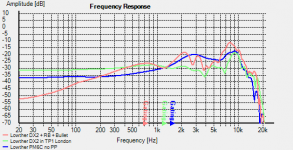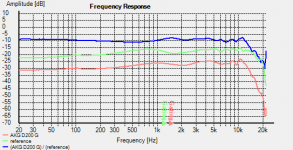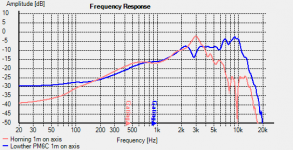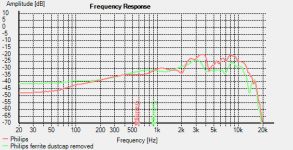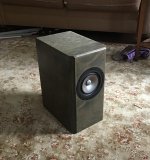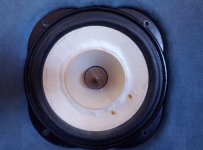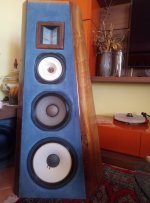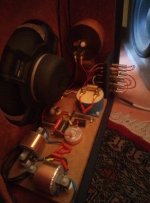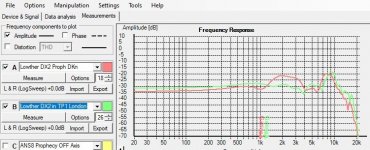I had a message today which is worthy of wider consideration, particularly also as a result of my not having familiarity with JBL drivers.
Lowther are really brilliant because they give us what we want in the sonic areas we want it. This is why for listening and musical appreciation and indeed for performance, Lowther brings music alive. However, as my correspondent says, using that for mixing is misleading.
The Lowther DX3 is not made for a forward facing environment. The PM6C might be the acceptable compromise between auditory excitement and flatness.
Here's the frequency response I measured of a PM6C in an infinite baffle, a DX2 and the PM6C in a Lowther TP1 horn.

Lowther units are made for different applications in different acoustic environments so one has to buy the right unit and use it in the right way.
I've been measuring microphones so have needed as flat a speaker as possible. The green line is a Tannoy 611 measured with a measurement microphone.

(I've been measuring responses of AKG D200 D202 D222 and D224 mics and others)
So it's the Tannoy 611 that I use for mixing purposes.
Here's the response of another Lowther PM6C as against the version modified by Horning removing the whizzer and to which is added a tweeter at around 6kHz from memory.

Here's the response of a Coral Flat 8 and a Tannoy DC100

Tannoy Gold 10 inch, Lynx 12 inch and DC100

Philips 8 inch with and without the dustcap removed

For mixing purposes a fullrange should be as flat as it can be. I would have confidence in my Lowther TP1s with DX2, and other Lowther cabinets with PM6C forward facing, possibly Coral, and possibly some Tannoy dual concentric units. My favourite drivers are the white 97db "Lowther challenge" units from David Louis Audio in China but they are not manufactured at present.
With regard to the enquiry above and the adhesive to use on a dustcap, if one's got one unit with a dustcap and one without, then measure it on and off axis, and try a phase plug too. If gluing a dustcap I'd use cyanoacrylate, superglue. It can be undone with acetone. For other things I use Copydex, a latex glue that can be peeled off if necessary.
Best wishes
David P
Lowther are really brilliant because they give us what we want in the sonic areas we want it. This is why for listening and musical appreciation and indeed for performance, Lowther brings music alive. However, as my correspondent says, using that for mixing is misleading.
I'm a musician and I'm trying to find an alternative to my lowther DX3 for mixing. I love them, so everything seems work fine, but the result, when I listen to my work in a normal system of reproduction, is not as good as I expected.
I'd need to try alternatives, maybe less pleasant sounding but more capable of made me able to do a better work.
I found some time ago a couple of JBL fullrange, a signature D208. One was scratching, the other had a broken cone, both with damaged dustcap.
I restored them, new spider and new surround, and I bought a pair of titanium 2" tweeter diaphragm to obtain a dustcap.
The question is that I'm very doubtful on which kind of adhesive can I use to assembly the dustcap to the voice coil former. Everything is ready to work, but I have to resolve this last step.
Please have you any kind of advice about this argument? I'd like to transmit as more information as possible from the paper voice coil former, the speakers sounds good to me and I have no limitations in restoring, I don't want to reach a like-as-new pair of JBL 208, I just have to try if I have found a more adeguate speaker for my mix.
Thank you in any case, I'm impressed about your experience and capability (building voice coil... I can't imagine it!!)
The Lowther DX3 is not made for a forward facing environment. The PM6C might be the acceptable compromise between auditory excitement and flatness.
Here's the frequency response I measured of a PM6C in an infinite baffle, a DX2 and the PM6C in a Lowther TP1 horn.
Lowther units are made for different applications in different acoustic environments so one has to buy the right unit and use it in the right way.
I've been measuring microphones so have needed as flat a speaker as possible. The green line is a Tannoy 611 measured with a measurement microphone.
(I've been measuring responses of AKG D200 D202 D222 and D224 mics and others)
So it's the Tannoy 611 that I use for mixing purposes.
Here's the response of another Lowther PM6C as against the version modified by Horning removing the whizzer and to which is added a tweeter at around 6kHz from memory.
Here's the response of a Coral Flat 8 and a Tannoy DC100
Tannoy Gold 10 inch, Lynx 12 inch and DC100
Philips 8 inch with and without the dustcap removed
For mixing purposes a fullrange should be as flat as it can be. I would have confidence in my Lowther TP1s with DX2, and other Lowther cabinets with PM6C forward facing, possibly Coral, and possibly some Tannoy dual concentric units. My favourite drivers are the white 97db "Lowther challenge" units from David Louis Audio in China but they are not manufactured at present.
With regard to the enquiry above and the adhesive to use on a dustcap, if one's got one unit with a dustcap and one without, then measure it on and off axis, and try a phase plug too. If gluing a dustcap I'd use cyanoacrylate, superglue. It can be undone with acetone. For other things I use Copydex, a latex glue that can be peeled off if necessary.
Best wishes
David P
Attachments
Member
Joined 2009
Paid Member
There's one and only one Lowther driver suitable for use without a horn, in my humble opinion, and that is the PM6A Silver voice coil. This one option avoids the treble peak that all the other units have. I believe Nelson Pass had come to a similar conclusion long before I knew what a Lowther was.
Use of a front horn to load the drivers that do have the treble peaks produces a balanced sound when implemented properly but if wanting a direct radiator without a front horn, all these other drivers are not likely to be neutral enough as a monitor.
There are many threads about monitors around here and by people with far more knowledge than I. I expect some of them may advise that headphones can be a viable alternative to speakers for mixing as they control more of the listening experience by eliminating the room.
Use of a front horn to load the drivers that do have the treble peaks produces a balanced sound when implemented properly but if wanting a direct radiator without a front horn, all these other drivers are not likely to be neutral enough as a monitor.
There are many threads about monitors around here and by people with far more knowledge than I. I expect some of them may advise that headphones can be a viable alternative to speakers for mixing as they control more of the listening experience by eliminating the room.
Last edited:
That's a really helpful observation and thank you so much! As it's not easy to identify the silver voice coil I don't know if I've experienced one!
Best wishes
David P
Best wishes
David P
None of those are really flat. Fullrange drivers are, altough i'm a fan, not really suited to build studio monitors. Their response and dispertion is not flat and the sound is coloured.
Better build a well balanced multiway for that. On the other hand, i did mix a lot of music on my Mark Audio Alpair 10M's in a sealed cabinet. But that is only because i know them inside out and know where the flaws are. And because i checked my mixes on Genelec and PMC monitors where i often have access to (in a radiostudio). But i'm now also busy on a try to build monitors, and it will be a 3 way with (partly) dsp to get it right.
Better build a well balanced multiway for that. On the other hand, i did mix a lot of music on my Mark Audio Alpair 10M's in a sealed cabinet. But that is only because i know them inside out and know where the flaws are. And because i checked my mixes on Genelec and PMC monitors where i often have access to (in a radiostudio). But i'm now also busy on a try to build monitors, and it will be a 3 way with (partly) dsp to get it right.
Yes - being aware of this is why I use the Tannoy 911 which are the flattest of speakers I've tested. Green line:
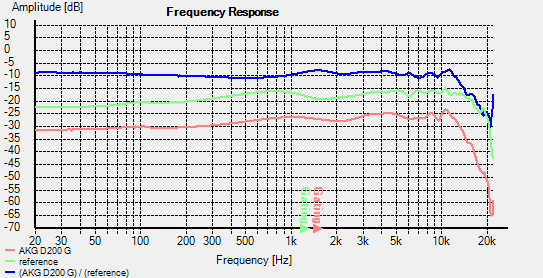
I'll try to find the response of the David Louis Audio units, which are impressive.
Does anyone have the frequency response of Manger? I had a pair and they were (boringly) flat to listen to but my son found them extremely good for mixing.
Best wishes
David P
I'll try to find the response of the David Louis Audio units, which are impressive.
Does anyone have the frequency response of Manger? I had a pair and they were (boringly) flat to listen to but my son found them extremely good for mixing.
Best wishes
David P
Hello to all and thank you a lot David for the advice about the glue, I'm the one who use Lowther for mixing. The "gold point" of using a fullrange is the absence of crossover, that I find excellent for phase linearity, especially in near field.
So many times I had troubles to find the right position in front of a two-way speaker, asking myself if the tonal balance reached in a particular vertical position could be the "real life" sound.
But yes, Lowther sings always too much "alive" (that I love a lot while listening music), and I have to work a lot to imagine a normal sounding situation.
The truth is that I've worked a lot (about six months) in my main house system to find a network to linearize the Lowther (I use them in a diy system for my lounge area, too) without make it "dead", and in my opinion I've found an optimal solution, but it's too complex and power hungry for the studio mixing (or I'm too lazy to replicate it...).
As one can see, the raise curve of a Lowther is a sequence of two or three quasi-6dB/oct. ones plus other specific resonance. I worked hard basing upon this considerations, and if it's true that it's quite impossible to obtain a flat curve from a Lowther, I reached a well balanced sound, no shout, no harshness, but alive and dynamic and preserving it's natural, marvelous phase coherency.
Anyway, pointing at the lower frequency sensibility start for linearize the response in a passive environment means that you waste a lot of power, plus you have to spend a lot for good quality passive components.
My future step is to replicate this circuit at line stage, using gyrator for simulated inductor to ground and Antoniou's solution for simulated series inductor, but very, very little time to do it...
In any case for my studio monitor I want to keep myself on the fullrange way, because I find them abolsutely clearer in terms of stage representation. Maybe I can try with Tannoy, but I expect a lot of work on crossover.
Next step I'll go with JBL 208, hoping in the meantime to manage to build the line simulator of my smoothing circuit for Lowthers, that I like a lot.
Sound is a strange beast, so abstract, so concrete...
good music to all, and thanks again, David
Massimo
So many times I had troubles to find the right position in front of a two-way speaker, asking myself if the tonal balance reached in a particular vertical position could be the "real life" sound.
But yes, Lowther sings always too much "alive" (that I love a lot while listening music), and I have to work a lot to imagine a normal sounding situation.
The truth is that I've worked a lot (about six months) in my main house system to find a network to linearize the Lowther (I use them in a diy system for my lounge area, too) without make it "dead", and in my opinion I've found an optimal solution, but it's too complex and power hungry for the studio mixing (or I'm too lazy to replicate it...).
As one can see, the raise curve of a Lowther is a sequence of two or three quasi-6dB/oct. ones plus other specific resonance. I worked hard basing upon this considerations, and if it's true that it's quite impossible to obtain a flat curve from a Lowther, I reached a well balanced sound, no shout, no harshness, but alive and dynamic and preserving it's natural, marvelous phase coherency.
Anyway, pointing at the lower frequency sensibility start for linearize the response in a passive environment means that you waste a lot of power, plus you have to spend a lot for good quality passive components.
My future step is to replicate this circuit at line stage, using gyrator for simulated inductor to ground and Antoniou's solution for simulated series inductor, but very, very little time to do it...
In any case for my studio monitor I want to keep myself on the fullrange way, because I find them abolsutely clearer in terms of stage representation. Maybe I can try with Tannoy, but I expect a lot of work on crossover.
Next step I'll go with JBL 208, hoping in the meantime to manage to build the line simulator of my smoothing circuit for Lowthers, that I like a lot.
Sound is a strange beast, so abstract, so concrete...
good music to all, and thanks again, David
Massimo
There's one and only one Lowther driver suitable for use without a horn, in my humble opinion, and that is the PM6A Silver voice coil.
i have a miniOnken design done for them.
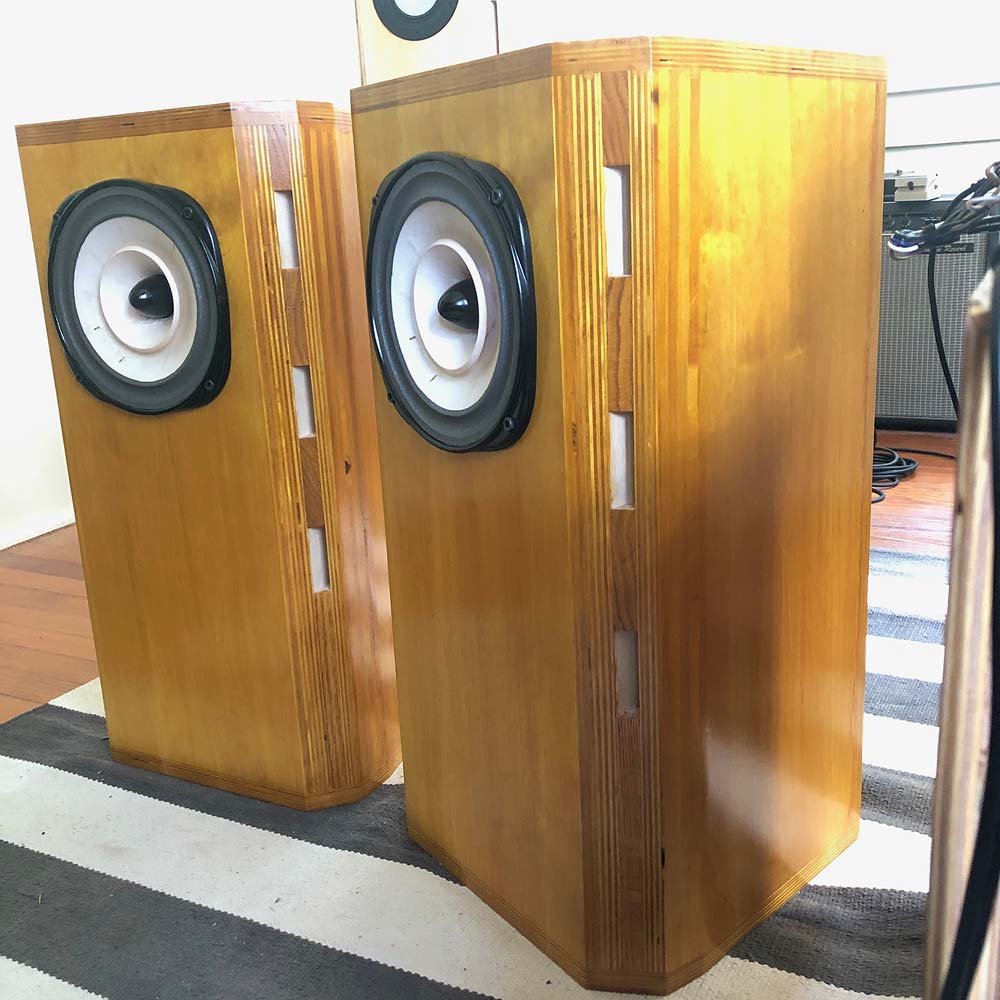
I have also adapted this box to the PM6c (looks to work well, but a bit more bass can be extracted from a larger box). I can’t speak for its top-end.
dave
Member
Joined 2009
Paid Member
great looking speakers Dave!
The MA10.3 is a good driver too, but it’s also slightly edgy in the treble whereas the 10p maybe not edgy enough but I believe it’s more accurate ?
The MA10.3 is a good driver too, but it’s also slightly edgy in the treble whereas the 10p maybe not edgy enough but I believe it’s more accurate ?
My take is that the A10.3 is more accurate, the A10p has a bit more vintage top end (ie as in seems MIA to some). I sold many more A10PeN than A10.3eN, the formaer a favorite of those with SE tube amps.
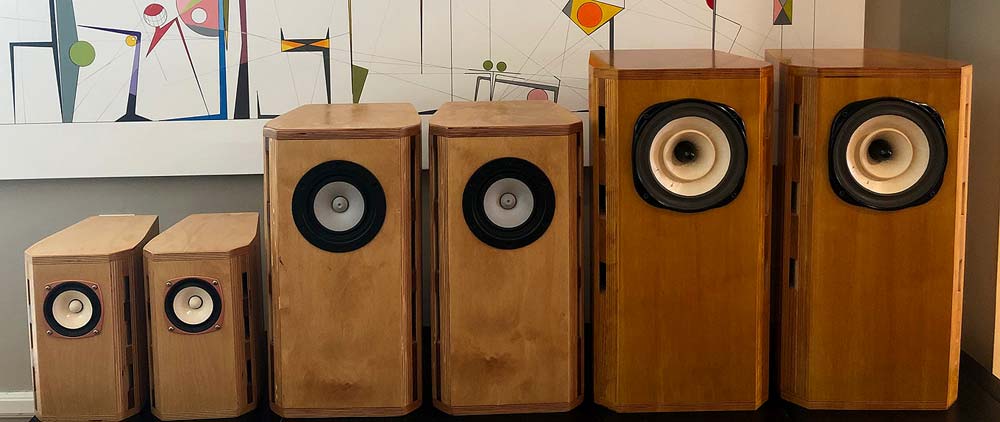
The Tan-Ken is Jeff’s 3rd trapezoidal miniOnken. On eof the earlier ones was for A10p, the other FE103SOL. IIRC he did describe what he felt were the differences in the tread where he 1st showed them off.
dave

The Tan-Ken is Jeff’s 3rd trapezoidal miniOnken. On eof the earlier ones was for A10p, the other FE103SOL. IIRC he did describe what he felt were the differences in the tread where he 1st showed them off.
dave
Member
Joined 2009
Paid Member
I hope that this has kicked off rather an interesting thread.
It appears that I haven't done a measurement that contrasts the Lowther units with and without the roll-back on the whizzer cone. Has anyone done that?
Personally I find the roll-back muddies the sound and makes them sound ordinary.
Best wishes
David P
It appears that I haven't done a measurement that contrasts the Lowther units with and without the roll-back on the whizzer cone. Has anyone done that?
Personally I find the roll-back muddies the sound and makes them sound ordinary.
Best wishes
David P
Hello, personally I prefer the roll-back ones, not only for a less sibilance concentration, but mainly for the ability to take in position a cotton ring that I find a very, very good improvement indispensable for the overall tonality in the middle region (says 1500÷2500 Hz).
Some photo of my main system, a quasi-fullrange based one, with AMT1 as energy filler and inductance compensation (it's a practically pure resistive load) in the last octave, and a couple formed by a JBL 123A and an Altec 408Y in series from 150Hz to down to the lower frequency of the dipole (about 65Hz).
From 65 to 16 works a couple of sub with Adire Shiva in transmission line with internal path non-squared section (IMF like). Some photos to have an idea of the work, especially of the compensation net I spoke about.
Surely I'll try other material for the cotton ring, not because it's ugly to see (who cares? I have to listen, not to view a picture) but because it slightly moves itself during reproduction, especially at higher pressure level. ...Maybe a light memory foam?
Massimo
Some photo of my main system, a quasi-fullrange based one, with AMT1 as energy filler and inductance compensation (it's a practically pure resistive load) in the last octave, and a couple formed by a JBL 123A and an Altec 408Y in series from 150Hz to down to the lower frequency of the dipole (about 65Hz).
From 65 to 16 works a couple of sub with Adire Shiva in transmission line with internal path non-squared section (IMF like). Some photos to have an idea of the work, especially of the compensation net I spoke about.
Surely I'll try other material for the cotton ring, not because it's ugly to see (who cares? I have to listen, not to view a picture) but because it slightly moves itself during reproduction, especially at higher pressure level. ...Maybe a light memory foam?
Massimo
Attachments
Ciao Massimo,
This is indeed a very interesting thread you and David have opened here, and I may be allowed to chime in with a few comments and thoughts, as I´ve been working with fullrange drivers and their correction as well since several years, for private use and since shortly, commercial as well. Please keep in mind that I´m actually offering FERTIN ACOUSTICS fullrange drivers for sale and am thus biased.
For whizzer damping (the so-called 99-cent-Lowther-modification) I use stuff called Soudal Kompriband (Soudal Kompriband Soudaband Fugendichtband Quellband vorkomprimiert BG1 | eBay) to good efforts. Weight is small, I cut off the gluing portion and stuff slightly between cone and whizzer, it stays there. Effects are measurable and listenable, but are twofold, reduction of resonances by damping will reduce detail and percepted subjective speed as well.
These whizzer resonances may, as you´ve done it, also be reduced with a passive circuit or dsp, but even if successfully reduced in level, they´re still there. The obvious solution is to do away with the whizzer or to use a petal whizzer, in order to avoid the single whizzer reflection at it´s end and to distribute resonances over a larger area and thus reducing their level. The roll-back of some whizzers is also a form of damping, like a rubber suspension damps cone resonances, and can be overdone with the same likeliness...
Using a fullrange system for mixing is indeed becoming more popular, especially in the nearfield console use, as here the advantages are quite obvious. But it´s also obvious that for mixing, we´ll need a certain amount of linearity and tonal correctness, so we´ll need some sort of correction. Most probably, assuming a fullrange speaker in some sort of enclosure, we will have baffle step effects, we will have a more or less rising response of the driver, and on top we might have resonance issues of the driver as well.
Let´s forget about diffraction, enclosure problems and other stuff for the moment.
These are, roughly categorized, our 3 "trouble areas.
Baffle step issues are due to baffle size and wavelength and are easily corrected. Non-correction will lead to a thin, unbalanced sound. The rising response is an effect of motor strength and should be dealt with as well, avoiding it with heavy cones and weak motors makes, in my personal opinion, no sense. This is also easily being controlled and will per se not introduce any resonances or trouble visible in a CSD.
Any resonances in our system are more difficult to deal with, as they´re often quite severe (it´s not uncommon to see breakups of 10dB to 20dB in measurements) and have a high Q. Beautiful manufacturers fr curves do not help here, we need honest measurements first and later fine-tuning per ear.
The trouble now is that even if we succeed in supressing those resonances, they´re only reduced in level, and we need to decide with which angle we measure and correct, as different angles will lead to different results.
I do believe that finding drivers with less severe breakups is better here, but as always YMMV.
In my personal opinion a sensible filter will better the balance and quality of most fullrange drivers I´m aware off (which have been many in the last decades, from Coral Beta 8 to Feastrex) or I have in posession (also quite a few...). This is a delicate job and needs to be realized in high quality, either passive or active or dsp (I prefer passive with good elements). The result of such filtering does not mean a perfectly flat system afterwards - this might be a goal with a multiway system, but with a fullrange system a response with a slight treble rise, in order to maintain a nice room response, is more suitable.
An advantage often overlooked is that while we´re reducing mid and lower treble area, high treble may be stronger in relation (with the filter done right) and thus extended.
I don´t agree so much in your statement that you´re waisting power with a correction, as I believe the sensitivity of a fullrange driver is determined at the lowest frequency it has to transmit, and we will start the correction from this point (more or less...). Of course we will loose efficiency in the breakup regions, but to me that´s actually wanted. Sadly, there´s a lot of BS going on with stated efficiency of many drivers. I´ve seen manufacturers claiming 107dB/2,8V/1m, but of course that´s only true in breakup area... having the same driver in a box or baffle, one will find that in the area of a few hundred Hz, we end up with around 90dB/2,8V/1m. Of course it would be nice to have 107dB over the full frequency range, but that´s pure phantasy for a 20-cm fullrange, same as claiming response from deepest bass to 50kHz...
Please don´t mix up crossovers with such a filter. A correction filter for a fullrange driver, as I have learned from others, will, if done right, result in a better phase response and in a better step response. Again, the subjectively right balance has to be found. And it´s easy to overdo it, resulting in a dull and boring, liveless speaker. Many will disagree here and will never accept any passive elements in front of their speakers, as always, speaker building is a compromise, and everyone has to find her or his own set of compromises she or he is happy with in the end.
Best regards
Mattes
This is indeed a very interesting thread you and David have opened here, and I may be allowed to chime in with a few comments and thoughts, as I´ve been working with fullrange drivers and their correction as well since several years, for private use and since shortly, commercial as well. Please keep in mind that I´m actually offering FERTIN ACOUSTICS fullrange drivers for sale and am thus biased.
For whizzer damping (the so-called 99-cent-Lowther-modification) I use stuff called Soudal Kompriband (Soudal Kompriband Soudaband Fugendichtband Quellband vorkomprimiert BG1 | eBay) to good efforts. Weight is small, I cut off the gluing portion and stuff slightly between cone and whizzer, it stays there. Effects are measurable and listenable, but are twofold, reduction of resonances by damping will reduce detail and percepted subjective speed as well.
These whizzer resonances may, as you´ve done it, also be reduced with a passive circuit or dsp, but even if successfully reduced in level, they´re still there. The obvious solution is to do away with the whizzer or to use a petal whizzer, in order to avoid the single whizzer reflection at it´s end and to distribute resonances over a larger area and thus reducing their level. The roll-back of some whizzers is also a form of damping, like a rubber suspension damps cone resonances, and can be overdone with the same likeliness...
Using a fullrange system for mixing is indeed becoming more popular, especially in the nearfield console use, as here the advantages are quite obvious. But it´s also obvious that for mixing, we´ll need a certain amount of linearity and tonal correctness, so we´ll need some sort of correction. Most probably, assuming a fullrange speaker in some sort of enclosure, we will have baffle step effects, we will have a more or less rising response of the driver, and on top we might have resonance issues of the driver as well.
Let´s forget about diffraction, enclosure problems and other stuff for the moment.
These are, roughly categorized, our 3 "trouble areas.
Baffle step issues are due to baffle size and wavelength and are easily corrected. Non-correction will lead to a thin, unbalanced sound. The rising response is an effect of motor strength and should be dealt with as well, avoiding it with heavy cones and weak motors makes, in my personal opinion, no sense. This is also easily being controlled and will per se not introduce any resonances or trouble visible in a CSD.
Any resonances in our system are more difficult to deal with, as they´re often quite severe (it´s not uncommon to see breakups of 10dB to 20dB in measurements) and have a high Q. Beautiful manufacturers fr curves do not help here, we need honest measurements first and later fine-tuning per ear.
The trouble now is that even if we succeed in supressing those resonances, they´re only reduced in level, and we need to decide with which angle we measure and correct, as different angles will lead to different results.
I do believe that finding drivers with less severe breakups is better here, but as always YMMV.
In my personal opinion a sensible filter will better the balance and quality of most fullrange drivers I´m aware off (which have been many in the last decades, from Coral Beta 8 to Feastrex) or I have in posession (also quite a few...). This is a delicate job and needs to be realized in high quality, either passive or active or dsp (I prefer passive with good elements). The result of such filtering does not mean a perfectly flat system afterwards - this might be a goal with a multiway system, but with a fullrange system a response with a slight treble rise, in order to maintain a nice room response, is more suitable.
An advantage often overlooked is that while we´re reducing mid and lower treble area, high treble may be stronger in relation (with the filter done right) and thus extended.
I don´t agree so much in your statement that you´re waisting power with a correction, as I believe the sensitivity of a fullrange driver is determined at the lowest frequency it has to transmit, and we will start the correction from this point (more or less...). Of course we will loose efficiency in the breakup regions, but to me that´s actually wanted. Sadly, there´s a lot of BS going on with stated efficiency of many drivers. I´ve seen manufacturers claiming 107dB/2,8V/1m, but of course that´s only true in breakup area... having the same driver in a box or baffle, one will find that in the area of a few hundred Hz, we end up with around 90dB/2,8V/1m. Of course it would be nice to have 107dB over the full frequency range, but that´s pure phantasy for a 20-cm fullrange, same as claiming response from deepest bass to 50kHz...
Please don´t mix up crossovers with such a filter. A correction filter for a fullrange driver, as I have learned from others, will, if done right, result in a better phase response and in a better step response. Again, the subjectively right balance has to be found. And it´s easy to overdo it, resulting in a dull and boring, liveless speaker. Many will disagree here and will never accept any passive elements in front of their speakers, as always, speaker building is a compromise, and everyone has to find her or his own set of compromises she or he is happy with in the end.
Best regards
Mattes
I started following this thread because I can't think of any driver less suitable for mixing than Lowthers.
Troels Gravesen tested the Lowther EX3 which confirms what I hear when listening to Lowthers: Extremely uneven frequency response, high distortion, uneven power response and a 180deg phase shift (not sure I could hear the last point though).
Lowther EX3
Troels Gravesen tested the Lowther EX3 which confirms what I hear when listening to Lowthers: Extremely uneven frequency response, high distortion, uneven power response and a 180deg phase shift (not sure I could hear the last point though).
Lowther EX3
I have Lowther TP1's in my listening room, among with JBL 703's and Dynaudio Focus speakers.
Disclaimer: I you can't mix on any random speaker, you can't mix.
But as the saying goes, it's easier to kill an elephant with a .50 and bury it with a JCB than it is to kill it by bombarding it with cotton wool and burying it with a teaspoon.
The Lowthers are the worst speakers I've ever listened to, extreme colouration and horrible of axis response. Its just impossible to make them sound even remotely good, trust me I've tried this for decades.
Good speakers, the ones that come out on top in double blind listening tests, have a uniform on and of axis response. The JBLs and Dynaudios fit that bill and sound great within their operating range. These kind of speakers also need a lot less acoustic adjustment in your room, 4 subs and a tiny bit of damping is enough for amazing results.
Disclaimer: I you can't mix on any random speaker, you can't mix.
But as the saying goes, it's easier to kill an elephant with a .50 and bury it with a JCB than it is to kill it by bombarding it with cotton wool and burying it with a teaspoon.
The Lowthers are the worst speakers I've ever listened to, extreme colouration and horrible of axis response. Its just impossible to make them sound even remotely good, trust me I've tried this for decades.
Good speakers, the ones that come out on top in double blind listening tests, have a uniform on and of axis response. The JBLs and Dynaudios fit that bill and sound great within their operating range. These kind of speakers also need a lot less acoustic adjustment in your room, 4 subs and a tiny bit of damping is enough for amazing results.
Member
Joined 2009
Paid Member
Let’s not make it a brand war - single full range drivers regardless of brand are always a serious compromise, even if in the extreme case of the worlds smoothest driver it involves a serious tradeoff for cost. Or a tradeoff on convenience because some drivers need large horns. For mixing, full range has neither the bass nor lack of cone resonances in the treble. A multi way is needed for accuracy.
Last edited:
I have Lowther TP1's in my listening room, among with JBL 703's and Dynaudio Focus speakers.
. . . .
The Lowether's are the worst speakers I've ever listened to, extreme colouration and horrible of axis response. Its just impossible to make them sound even remotely good, trust me I've tried this for decades.
Um. That begs the question as to why you give the TP1s houseroom.
On other threads I've mentioned that one of the problems with Lowther isn't the speakers but how people used the drive units, and making sure that the drive units match with their environment.
I had EX4 in my TP1s and bass wasn't good. Using DX 2 and they are flat.
And there are variations with the TP1s - the London version of the 1970s and 80s was a 500Hz horn and the Imperator version is a 150Hz horn. Add to that variations of phase plug - bullet vs pepperpot vs doorknob and there are more variables, together with whizzer with and without rollback.
There are enough people who swear by Lowther that they really can't all be wrong but there are enough variables in the use of units and their choice for many people to have experienced them wrong.
My TP1s are the London variety and they sound very good with DX2, no rollback, and bullet phaseplug. Here's the frequency response of my DX2 with bullet in the TP1 London and with a doorknob in the Prophecy 150hz TP1 based horns:
Even the measurments of the doorknob are critical - from memory they have to be under 68mm. Above 68mm is deleterous.
So a brand of speakers which relies very much on natural acoustic properties does exactly that, and they can respond by physical parameters under the user's control. For mixing one might find it easier to use speakers amenable to electronic control with crossovers, but that's not necessarily what one enjoys actually listening to.
The magic of Lowthers, and I mean just that, is that they give very detailed and full auditory information at very low volume levels and in this area others cannot compete so well. If living in a terraced house where loud music will disturb neighbours, then the Lowthers can reproduce particularly satisfactorily at levels which don't disturb neighbours. Other speakers with crossovers in the 1khz to 2khz region have to be played loudly so that the ear can determine the confused detail in that region.
In my opinion dual concentrics such as the Tannoy ameliorate that confusion to some extent and the flatness of the 611 and DC100 that I've measured gives me confidence in knowing better what I'm putting into a recording.
When listening to it however, what are considered to be the deficiencies of speakers with bumps and dips in the frequency response graph actually make reproductions through those speakers alive.
I add cone extensions to whizzers of full range units to bring them to the sort of dimensioins of the Lowther design. Sometimes these are not helpful but at times the resulting bumps they introduce into the frequency curve make the speakers sound more "musical".
So there are no right answers, what one hears can be what one wants to hear, or sound useful to hear for a purpose such as mixing, and perhaps not. When not, perhaps it's not that any brand in general is bad or good but perhaps how one's using it, how one's experiencing it, and that there are alternatives both in acoustics in the use of that brand and alternatives also.
For my part, the TP1 London with DX2 essentially flat from bass to 7khz gives me all I need and the 9kHz bump up top probably compensates for my loss of hearing above 11khz. Such is the curse of age. When monitoring, being able to hear the 9k bump I'm probably subconsciously aware that probably there's enough recorded signal in the top octave I can no longer hear.
Best wishes
David P
Attachments
There's one and only one Lowther driver suitable for use without a horn, in my humble opinion, and that is the PM6A Silver voice coil. This one option avoids the treble peak that all the other units have. I believe Nelson Pass had come to a similar conclusion long before I knew what a Lowther was.
Absolutely, although the now-defunct PM8 (silver coil) also, if fallible memory serves, fell into this somewhat more linear category.
Use of a front horn to load the drivers that do have the treble peaks produces a balanced sound when implemented properly but if wanting a direct radiator without a front horn, all these other drivers are not likely to be neutral enough as a monitor.
Not without significant EQ (electrical or mechanical), that's for sure. Which is viable, but speaking as someone who designs wideband & multiway systems, beyond a certain point I'd rather not implement significant amounts of correction / corrective measures to wideband drivers. If that's what's needed to make them play ball, you either need different drivers, or shift to a multiway. Some exceptions of course, notably arrays, but that's about dealing with a system rather than a driver effect per se.
Um. That begs the question as to why you give the TP1s houseroom.
David P
To let people hear them.
There's a lot of people who think that single driver horns with single ended direct heated triodes are audio nirvana. And its vers easy to fool yourself with spending lots of money and biased listening tests.
Harmonic distortion creates the illussion of more low level detail, lower level sounds get higher in level. And it creates the illusion of more percussive impact, because more inner ear bands are exited.
Its like alway's wearing pink sunglasses.
Let’s not make it a brand war...
Not a brand war, I'd extent that to all drivers with whizzer cones.
- Home
- Loudspeakers
- Full Range
- Lowther vs JBL vs Tannoy for mixing
